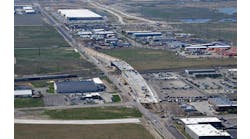By Darrell Russell Contributing Author
Plant species that jeopardize roadway safety and the integrity of transportation infrastructure create a challenge for departments of transportation and local officials who manage roads.
There are various strategies for this type of roadway management, but many commonly used practices negatively impact ecological health and environmental sustainability.
For example, mechanical mowing practices are used to control unwanted vegetation throughout roadside right-of-ways (ROW). Current mowing strategies target undesirable plant species as effectively as they decimate desirable plants that would otherwise benefit a host of beneficial insects and animals, such as ground nesting birds, reptiles and amphibians, as well as migrating pollinators like the Monarch butterfly, all of which contribute to ecological biodiversity.
Existing mowing practices often lead to soil compaction, rutting, and erosion. Associated strategies also can scatter litter and debris throughout roadway corridors, which can cause harm to automobiles and motorists alike.
Selective herbicide applications, which kill only certain target plants, could offer a refined approach compared with mowing practices.
These quality treatments control incompatible vegetation that impedes roadway visibility, compromise the integrity of transportation infrastructure, and supplants biodiverse wildlife habitat.
Enhancing Safety and Biodiversity
Most selective herbicide applications leave desirable vegetation unharmed, yielding areas in which native plants and wildlife species can flourish. Comparatively, mowing practices stimulate seed spreading and the reestablishment of troublesome weeds and brush species that cause persistent issues throughout roadside ROW and adjacent ecosystems, including: obstructed visibility for motorists, compromised pavement integrity, restricted development of native plants, and soil erosion.
After selective herbicide applications are used along roadways, a desirable plant community can form a biological barrier against the reestablishment of incompatible plant species. The presence of native grasses and flowering plants enhances roadway safety, infrastructure protection, and the development of biodiverse habitat for native wildlife.
Habitat loss has been a leading cause of declining pollinator populations since the 1990s. This form of road maintenance can provide ample support to bees, butterflies, and other pollinators that play a critical role in approximately one-third of our global food supply.
Three-Zone Approach
Selective herbicide applications can be continuously customized to meet the diverse needs of unique ROW corridors. Licensed applicators can use different chemistries and spraying equipment to maintain novel control of incompatible vegetation regardless of terrain, temperature, or climate.
That’s why these adaptable solutions are commonly used to maintain control of problematic plants for roadside vegetation management programs comprised of three key zones:
Zone 1: The vegetation-free zone. Composed primarily of gravel shoulders, the vegetation-free zone is no place for plants or wildlife of any kind. Keeping these areas clear of grasses, broadleaf weeds, and noxious or invasive plants requires total vegetation control. Broadcast or spot treatments of herbicide chemistries in this zone can yield bareground results, which improves visibility and maintenance of roadside hardware, enhances surface drainage, and prevents pavement breakup caused by plants.
Zone 2: The operational zone. The operational zone should be maintained to provide a hazard-free vehicle recovery area, making visibility for passing or stopping motorists essential — particularly near intersections. To achieve beneficial results and maintain the hydraulic capacity of ditches, the height of vegetation in this area should be kept below 30 inches. This supports the development of regenerative ROW corridors composed of deeply rooted perennial plants that provide ample sight distance.
Zone 3: The transition zone. Consisting of all land between the end of the operational zone and the outer edge of a ROW, the transition zone is the best place for vegetation managers to enhance environmental sustainability. Using backpack sprayers to control incompatible brush species in this area supports the establishment of native plants that not only improve sight distance, but also support biodiverse habitat development for pollinators and other native wildlife species.
Various chemistries can achieve sustainable results in each of these zones. However, the resiliency of certain plants can slowly build a tolerance to herbicide products over time. Fortunately, dependable solutions are available to help roadside vegetation managers maintain effective control of targeted plants without having to upend their planned treatment cycles.
Resistance Management
No herbicide is invincible — not even the most effective chemistries on the market. In fact, many vegetation managers working in areas adjacent to transportation infrastructure have found that herbicide resistance most commonly occurs in areas where roadways and agricultural sites intersect. That’s likely because mowers and other agricultural equipment often deposit seeds from resistant species along roadsides whenever they’re transported from one site to the next.
When resistant plants display the ability to survive and reproduce after exposure to previously effective herbicide applications, vegetation managers must reassess the chemistries in their arsenal to fortify resistance management. Simply increasing application rates will only lead to higher costs, which is why these adjustments play a pivotal role in the efficacy and cost efficiency of vegetation management programs.
Product rotations enable vegetation managers to introduce new modes of action that are engineered to optimize control of various weed and brush species.
Targeted herbicide treatments consisting of selective chemistries creates landscapes that require less product and manpower to maintain.
As an added benefit, intentionally managing both compatible and incompatible vegetation qualifies for Envoronmental Social, and Governance reporting (ESG) when results are proven to yield no net loss or net positive impact on biodiversity.
Reporting quantitative or qualitative results through the ESG allows organizations to proactively offset industry headwinds and increase understanding of the impact their vegetation management strategies have on environmental sustainability.
Transforming roadside ROW into biodiverse landscapes doesn’t happen overnight. However, making adjustments today to embrace the multistaged process can benefit transportation infrastructure, environmental sustainability, and the general public for generations to come. R&B
Darrell Russell is a vegetation management specialist with Corteva Agriscience.



